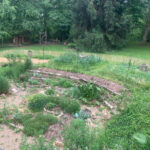I attended a talk, titled “Local Food Starts at Home” and sponsored by two knowledgeable friends of mine, that focused on increasing awareness of local foods and building a sustainable foodshed in the future for our area. At the beginning of the talk, Trevor and Mark presented a detailed history of food production in the area, dating back to the Native American tribes. One of the most important things I took away from this talk was the importance of understanding the history of our local area so that we can help save our future. In our culture, there is an assumption, often faulty, that things are continually progressing and that life before wasn’t as good/comfortable/happy/fulfilled/engaging as it was before. But our pasts, our local histories, have much to teach us about sustainable living and offer much wisdom for the future.
So what’s in local history that can help us make a sustainable transition today? Let’s look at some of the history of my own town Clarkston, MI, as presented at the “Local Food Starts at Home” talk.
In South East Michigan, several nomadic Native American tribes engaged in hunting and wild harvesting (rice, nuts, berries) throughout my local area. They tended these wild spaces to produce foods, although these spaces were more wild food forests than traditional cultivated gardens (some Native Americans in other parts of the USA did have such cultivated gardens, such as the Hidatsa as explained in Buffalo Bird Woman’s Garden). The amounts of knowledge that these nomadic tribes had–and that now is irrevocably lost–is staggering. Information on foraging for foods, what to eat, how to preserve it, how to cook it, medicinal qualities and other uses–all of this rich history gone as the Native Americans were forced south and west of SE Michigan.

Because the native tribes’ cultivation of land was minimal and unlike anything typical Europeans did, when white settlers came in the 1840’s, they didn’t recognize these edible forests as cultivated at all. They, therefore, brought their European ways of producing food with them: tilling and farming technologies, animal husbandry, and various crops. In downtown Clarkston, they built a mill using water power and used that mill extensively to mill grain and saw logs. The forests of Michigan, in about a 40-year period, nearly disappeared as white settlers exported lumber and other products. Even with their less-than-respectful ways towards the land, the settlers still have much to teach us today about natural living. They used the river and the wind as sources of energy, which were renewable. They had a nearly 100% local economy–the town produced everything it needed, from wooden cider barrels from woodworkers, to shoes from cobblers, to farm equipment from one of the three local blacksmiths. They saved seeds season after season, and grew varieties that flourished in our local conditions. And every family, in town or outside of it, grew a substantial portion of their own food through vegetable gardens. The modern idea of the “lawn”, which consumes more than it produces (and which I’ve blogged about before), isn’t present in the old photographs and records. It wasn’t until 1910-1930 that much of this way of life was lost.
With the transition to increasing technology, including cars, radio, and later, television, historical records suggest that many of the old-timers in the area saw more loss than gain. Materials and goods could be shipped further, eliminating the need for local blacksmiths or cobblers. People started going inside to listen to radios and watch television rather than entertain themselves as a community with dances, celebrations, and feasts (this is also a subject I’ve blogged about before). When the new ways came, most embraced them wholeheartedly, while not realizing what was lost in the process. When the food system was shifted from local to national or international, we also saw a loss of local capital–economically, the money being spent in a town no longer stayed in the hands of its citizens but rather was filtered into the hands of the wealthy few.

I suspect that the history of Clarkston mirrors the history of many areas in the USA. There might be a different timescale or different details, but the shift from a local economy, producing its own food and goods and living in relative security and independence took place. In nearly all places, across the course of the 20th century, we have a current global system, where tomatoes might be grown in Ontario hydroponically, shipped to Texas for processing, and then shipped to New England to be sold. This takes the power out of the hands of individuals, of communities, and into the hands of corporations who have no vested interest investing locally or promoting positive change in a community.
Learning about our past can give us a greater understanding of what techniques worked in a local area and what possibilities we have for making a successful transition to a sustainable future. I encourage blog readers to investigate the histories of their own communities–what was there before Walmart and Bank of America? How did people live? What did they grow? What aspects of our own histories might be something we can use for inspiration today? Look at your local library, local historical society, and even in family archives. Talk to the elderly and record their stories–they have much to teach us.
And then, once you are empowered with such knowledge, think about how it can be used in your local community today. How much would a community, family, or individual gain if everyone grew their own vegetables? If everyone committed to at least a 20% local diet? What would that do for our own local economies and well being? We need to stop depending upon a system that has failed us. We need to create new, better systems locally, using the past for inspiration for our futures.

